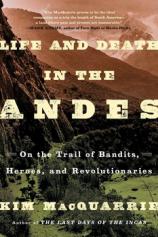Life and Death in the Andes: On the Trail of Bandits, Heroes, and Revolutionaries
Review
Life and Death in the Andes: On the Trail of Bandits, Heroes, and Revolutionaries
Kim MacQuarrie, a documentary filmmaker and author of THE LAST DAYS OF THE INCAS, has written a history/travelogue about a continent that still remains a mystery to many of its northern neighbors: South America. Focused on the 4,300-mile-long mountain range that cuts through the western side of the continent, LIFE AND DEATH IN THE ANDES has --- as the subtitle attests --- a lot of material with which to work. Familiar names like Che Guevara, Butch Cassidy and, of course, Charles Darwin are found in these pages, with full chapters devoted to some, while others are referred to in passing. (Darwin, as befits his stature, actually gets two.)
Hiram Bingham, who “discovered” Machu Pichu, gets his own few pages, but, like many whose portraits hang here, his story is filled with dramatic twists. A professor of Latin American studies at Yale, Bingham discovered what he thought was the ancient Inca city of Vilcambaba in 1911. He returned to the U.S. claiming to have unearthed the lost city, but eventually those claims were disputed, and the artifacts he had shipped back from the site were labeled stolen goods. Later in life, after he had been elected to office, he was censured by the U.S. Senate.
"[F]or anyone who has been to South America, or dreams of going, LIFE AND DEATH IN THE ANDES brings its people and the gorgeous, oftentimes awe-inspiring, country alive."
MacQuarrie, who lived in Peru for five years and knows the terrain well, is not afraid to personalize these stories with his own modern-day experiences. In fact, traveling the path of his characters is an important part of the book’s fabric. In 1987, he drove around northern Peru with Norwegian explorer Thor Heyerdahl, and earlier in this century he tells of meeting Pablo’s brother, Roberto Escobar, at the family home just outside of Medellín, Colombia. At times, the author brings in traveling companions, whose questions and exclamations allow him to expand on some point he wants to make. Sometimes the companions hijack the story, as in the chapter about the discovery of the frozen body of Juanita, the Princess of Ampato, who was sacrificed to the Inca gods. MacQuarrie narrates her last days leading up to her death, while introducing the reader to modern-day weavers who compete to reproduce the clothing she wore when killed. The back and forth between 16th-century Cusco and 21st-century Chinchero is head-spinning at times.
Still, MacQuarrie’s desire to persuade the reader that this terrain and these stories are not just entertaining but also significant infuses the book with energy. He also wants the reader to understand how much perceptions of the continent as lawless and dangerous are based either on myth or on a past that no longer represents modern-day South America. Coincidentally, another book just came out that does a similar job of explaining --- and promoting --- a critical geographic area through stories. Simon Winchester’s PACIFIC takes 10 areas around the ocean and creates narratives that illustrate why a specific locale and history are important in understanding the region. MacQuarrie picks nine, with a similar purpose --- though his own experiences feature more in the stories, and his writing perhaps is not as masterful as the brilliant Winchester’s.
But for anyone who has been to South America, or dreams of going, LIFE AND DEATH IN THE ANDES brings its people and the gorgeous, oftentimes awe-inspiring, country alive.
Reviewed by Lorraine W. Shanley on December 11, 2015
Life and Death in the Andes: On the Trail of Bandits, Heroes, and Revolutionaries
- Publication Date: December 13, 2016
- Genres: History, Nonfiction
- Paperback: 448 pages
- Publisher: Simon & Schuster
- ISBN-10: 1439168903
- ISBN-13: 9781439168905





